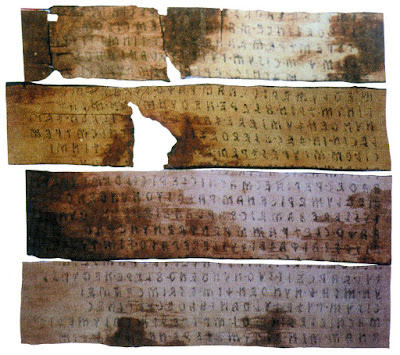From
19 March 2016 until 31 July 2016, a fascinating
Etruscan exhibition focussed on the script used in Etruscan writing is taking place at the
Museo dell'Accademia Etrusca e della Città di Cortona, in
Cortona - itself an Etruscan foundation, site of several
Etruscan tombs and a member of the
Etruscan dodecapoli. I strongly recommend this exhibition to anyone with an interest in this fascinating people.
 |
| Etruscan tessera d'ospitalità |
The aspect of the Etruscan language that most immediately springs to mind is that even now, despite intensive study, it is still not well understood, even though it can be read fairly easily when written down, as it usually is, in a variant of the Greek alphabet. This is especially the case with regard to the specific meanings of individual words, which are unrelated to the vocabulary of the Indo-European languages such as the Greek and Latin. This reduced level of comprehension of the Etruscan language is the result of the paucity of extant long texts - the entire Etruscan literary corpus has been lost - and of the brevity and repetitiveness of Etruscan funerary, legal and commercial texts.This has helped to create an aura of mystery around the Etruscan language and the Etruscan people. The mystery of the origin of the Etruscans draws nourishment from a
language that seemed incomprehensible and
archaic, even to contemporary ears. In addition, this air of mystery was exacerbated by 19th century archaeological excavations that were mainly investigations of graves and everything that goes with them, including the meticulous Etruscan funerary rituals in preparation for the afterlife. Lists of
Etruscan gods and goddesses are well-established, but little else.
 |
| Etruscan perfume jar |
The spread of Etruscan language and its script is an unusual topic
since we (or, anyway, I) generally think of the Etruscans as a static
people whiling away their time quaffing wine and playing double pipes in the Tuscan sunshine. However, it seems
there was probably a degree of diffusion of the Etruscan language
through conquests, trade contacts and, especially, the spread of Etruscan religion around the
Mediterranean basin between the 7th century and the 1st century BC. Recent discoveries of Etruscan inscriptions at a site near Lattes, in the south of the prefecture of Montpellier, suggest the presence of Etruscan merchants in France, possibly for an extended period. It is even possible that Germanic runes (
Futharc) are derived from the Etruscan alphabet.
 |
| Etruscan Tabula cortonensis |
This exhibition and its catalogue beautifully illustrate the latest research in the field of of Etruscan
syntax, grammar and vocabulary, based on numerous inscriptions, some of
them completely new. Some major examples of Etruscan epigraphy are displayed together for the first time. Progress in the comprehension of the Etruscan language was assisted by the discovery in Cortona a few years ago of the
Tabula cortonensis, the third longest Etruscan text so far known (after the
Liber lintaeus of Zagreb and the
Capua Tablet). The
Tabula cortonensis is a land transfer agreement, some 40 lines long. Of the longer inscriptions, the most important is the Zagreb mummy wrapping or
Liber Lintaeus found in Egypt in the 19th century and carried back to Yugoslavia by a traveler. It had originally been a book made of linen, which was cut up into strips to be wrapped around a mummy. With about 1,300 words, written in black ink on the linen, it is the longest existing Etruscan text. It contains a calendar and instructions for sacrifice, which are sufficient to convey some idea of Etruscan religious literature.
 |
| Etruscan liber lintaeus |
Of course, bilingual texts are the key to interpretation of an unknown language, and for Etruscan there is a single important example, namely the
Pyrgi Lamellae, two inscribed gold plaques found at the site of the ancient sanctuary of Pyrgi, the port city of Caere, modern Cerveteri, 50-60 km NNW of Rome. These plates provide two texts of significant length (about 40 words) and of similar content, one in Etruscan and the other in Phoenician. They offer substantial data for the elucidation of Etruscan by way of Phoenician, a known language. The find is also an important historical document that records the dedication to the Phoenician goddess Astarte of a "sacred place" in the Etruscan sanctuary of Pyrgi by Thefarie Velianas, king of Caere, early in the 5th century BC.
 |
| The Etruscan Pyrgi Lamellae |
My review of the Etruscan exhibition in Cortona, March through July 2014.
 |
Don't forget to visit my Tuscany
Travel Guide!
Up-to-date news on what to see and where to stay in Chianti and all of Tuscany.
Tuscany Travel Guide
|
|
Author: Anna Maria Baldini









